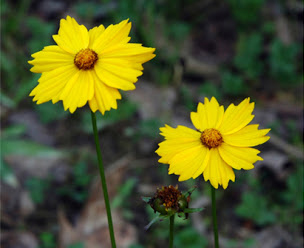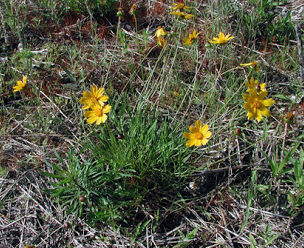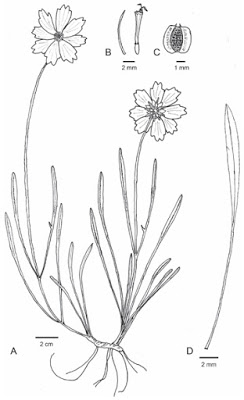Welcome Baker’s tickseed
by Claudia Larsen
Follow this new species’ journey from discovery to naming
Recently discovered in North Florida’s Jackson County, Coreopsis bakeri has gone undetected for years because of its resemblance to our common Lanceleaf tickseed (Coreopsis lanceolata). Several years of scientific study finally proved that, indeed, it is has been isolated long enough to have become a distinct species, bringing our state’s total native Coreopsis species to 14, and North America’s total to 39.


The new species is named for Wilson Baker, the Florida naturalist who discovered it along with Ann Johnson, a Florida Natural Areas Inventory community ecologist. Baker has studied rare plants of Florida’s glades since the 1980s. The plant may be endemic to Jackson County and may soon be nominated for the ranking of “endangered” by the U.S. Fish and Wildlife Service.
Baker’s tickseed is described as having yellow flowers and narrow glabrous, infolded leaves, while the similar lanceleaf tickseed bears pubescent leaves. C. bakeri apparently diversified in order to survive in Jackson County’s upland limestone glades, where it was collected in April 2013. These glades feature rock outcrops with very thin poor soil, making them unique with many special plants that survive there. Grasses and herbaceous shrubs characterize the glade landscape, which is also home to plants rarely found in Florida, such as Green milkweed (Asclepias viridiflora), Poppy mallow (Callirhoe papaver), Small-toothed sedge (Carex microdonta), Carolina larkspur (Delphinium carolinianum), Shootingstar (Dodecatheon meadia), Eastern purple coneflower (Echinacea purpurea), Little-people (Lepuropetalon spathulatum), Pinnate-lobed coneflower (Rudbeckia triloba var. pinnatiloba), Nettle-leaved sage (Salvia urticifolia), and Shade betony (Stachys crenata). C. bakeri has so far been found in nine glades, including one in Florida Caverns State Park, where it is protected from encroachment by mining operations that often destroy these rare habitats.
Determining new species status
The site, a former cattle pasture and citrus grove, is being enhanced with thousands of native plants, shrubs, small trees and grasses, including hundreds of milkweeds — the host plant of the Monarch butterfly. The new habitat will provide cover, nectar and nesting opportunities for dozens of insect and animal species.
State Road 429 and Wekiwa Springs State Park. It serves as part of the Wekiwa-Ocala Greenway, a wildlife corridor connecting the state park with Seminole State Forest and the Ocala National Forest. Besides butterflies, bees and an array of beneficial insects, the site is expected to be used by abundant wildlife traveling the corridor, including gopher tortoises, sandhill cranes, deer and black bears.
Since plants have similar leaf, flower and seed structures, how can we verify that a species is truly different? Historically, plant morphology and biochemistry had been used for taxonomic descriptions, so C. bakeri’s unique leaves and early flowering singled out the plant for consideration. Recently, phylogenetics also has been employed to explore evolutionary relationships and heritable traits in DNA.
To confirm its new listing, C. bakeri seed was collected in Florida and taken to the University of Tennessee, where it was propagated both outdoors and in a greenhouse. Seed was then collected and propagated from the new plants. The subsequent plants retained their distinctive qualities. C. bakeri was also crossed with C. lanceolata, the progeny of which produced seed that germinated readily, showing that C. bakeri can hybridize with other Coreopsis species. This may be a peril to the new species if populations are near naturalized or planted C. lanceolata. Further DNA studies conducted by Dr. Edward E. Schilling of UT’s Department of Ecology and Evolutionary Biology compared C. bakeri with other Coreopsis species. Results showed a distinct difference between C. bakeri and C. lanceolata, proving they are genetically different species.

Genetic (DNA) barcoding is a new tool being employed for species identification. It has been especially helpful in identifying fossil and degraded herbarium specimens. Genetic barcoding uses nuclear ribosomal ITS markers to compare polymorphism features on a molecular level. Barcoding has been instrumental in proving biodiversity, identifying juveniles and for forensic study. Further study across a large group of plants is still necessary to develop this technique for accuracy and dependability in plant taxonomy.
Using DNA technology in plant taxonomy
Genetic material (DNA) is isolated from fresh or dried leaf samples. The material is finely ground before a chemical mixture is added to buffer and isolate the genetic material. DNA is extracted and submitted to an amplification process. It is then sequenced, and plastid genome spacer regions are identified and compared using DNA analyzer equipment and computer software that interprets phylogeny based on mathematical modeling. Two gene regions in the chloroplasts serve as the barcode region in plants and sequencing protocols must be developed for each plant genus. This helps differentiate between some but not all Coreopsis species. In this case, Coreopsis bakeri appears to have distinct characteristics.
There are two DNA barcode databases used by museums, herbaria and researchers: Barcode of Life Data Systems and International Nucleotide Sequence Database Collaboration. These databases organize records from many projects and merge them into a “virtual project” that can form DNA “trees” for plant and animal specimen.
Some notes on scientific nomenclature
- “Genus” signifies a group of plants sharing common characteristics and evolving from the same ancestor.
- “Species” is the largest group of plants within a genus capable of producing fertile offspring. Species are determined by DNA, morphology or ecological niche.
- Plants with locally adapted traits are referred to as “subspecies” or “varieties.”
- “Taxon” (plural “taxa”) refers to a group or category within a system of classification.
The steps in naming the new species “Coreopsis bakeri”
The naming of plants has a tumultuous history guided by international rules to ensure there is only one name for each plant species. All new taxa must be described and published as a permanent record in a scientific journal. The rules state that the name must be based on the Latin alphabet, must be unique and describe the taxon or differentiate it from other taxa, and must also have a real specimen stored in an herbarium. The person who discovered the plant (the author) also may be listed or abbreviated after the plant name.
Plant names are approved by the International Code of Nomenclature for algae, fungi and plants, which is governed by the International Botanical Congress and the International Association for Plant Taxonomy. These organizations also facilitate international cooperation among botanists working in the fields of plant systematics, taxonomy and nomenclature.
The Angiosperm Phylogeny Group (APG) consists of international researchers who compile an up-to-date accepted classification of plant names, which considers evolutionary DNA evidence. Two University of Florida researchers, Pamela S. Soltis and Douglas E. Soltis, are members of APG, along with authors from Kew Royal Botanic Gardens, Swedish Academy of Sciences, Stockholm and Uppsala universities, Harvard, Cornell, University of Maryland and University of Missouri. The APG website, hosted by Missouri Botanical Garden, is a great source for the latest information on plant names supported by APG.
Bibliography
- Schilling, Edward E, Johnson, Ann F. & Jacona, GD. “Coreopsis bakeri (Asteraceae; Coreopsideae), a new species from Florida, USA.” Phytotaxa 231(2) 175-181. http://www.mapress.com/phytotaxa/content/2015/f/pt00231p181.pdf
- DeSisto, Joseph. “The Limestone Flower.” The New Species Challenge (blog). October 20, 2015. (Link no longer available)
- Upland Glade Habitat Description, 2009 Florida Natural Areas Inventory. www.fnai.org/PDF/NC/Upland_Glade_Final_2010.pdf
- Barcode of Life Data Systems. http://boldsystems.org/
